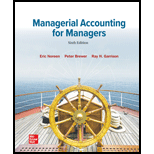
1.
Introduction: The transfer price refers to the price at which the goods and services are exchanged between companies under common control or between divisions of the same company.
The value of the lowest acceptable transfer price for the selling division, the highest acceptable transfer price for the buying division, the range of acceptable transfer price and will the managers voluntarily agree to transfer the units along with the reasons for the same.
2.
Introduction: The transfer price refers to the price at which the goods and services are exchanged between companies under common control or between divisions of the same company.
To explain: The effect on the profits of the P Division, C division, and the entire company due to the change in the supply price of the P division.
3.
Introduction: The transfer price refers to the price at which the goods and services are exchanged between companies under common control or between divisions of the same company.
The value of the lowest acceptable transfer price for the selling division, the highest acceptable transfer price for the buying division, the range of acceptable transfer prices and will the managers voluntarily agree to transfer units within the divisions along with the reason for the same.
4.
Introduction: The transfer price is the price that is charged by one department of the company to another department of the same company for the transfer of goods and services.
The P Division should meet the price of the outside supplier or not.
The effect on the profits of the company as a whole when the P Division does not meet the price of the outside supplier.
5.
Introduction: The transfer price is the price that is charged by one department of the company to another department of the same company for the transfer of goods and services.
Whether the C Division should purchase from the P Division at a higher price for the good of the company as a whole.
6.
Introduction: The transfer price is the price that is charged by one department of the company to another department of the same company for the transfer of goods and services.
The effect on the profits of the company as a whole when the C Division is required to purchase 5,000 tons of pulp each year from the P Division at $70 per ton.
Want to see the full answer?
Check out a sample textbook solution
Chapter 11 Solutions
Loose Leaf For Managerial Accounting for Managers
- XcellGraphics is a printing company that uses a job-order costing system. The firm expects to have $75,000 in indirect costs and $125,000 in direct labor costs. The cost of direct labor is $45 per hour. At the end of the period, overhead was underallocated by $14,500. What was XcellGraphics' actual manufacturing overhead cost if work completed during the period required 3,900 direct labor hours?arrow_forwardPlease explain the solution to this general accounting problem with accurate explanations.arrow_forwardThe overhead assigned to each unit of product x?arrow_forward
- What is the total sales value?arrow_forwardMajestic Supplies, Inc. sells office equipment with credit terms of 3/10, net 30. Based on experience, 75 percent of all customers will take the discount. What is the average collection period?arrow_forwardCalculate the predetermined overhead ratearrow_forward
- Please provide the solution to this general accounting question using proper accounting principles.arrow_forwardCan you solve this financial accounting problem with appropriate steps and explanations?arrow_forwardMurray Industries applies manufacturing overhead to its cost objects on the basis of 75% of direct material cost. If Job 37A had $96,000 of manufacturing overhead applied to it during July, the direct materials assigned to Job 37A was: A. $72,000 B. $96,000 C. $128,000 D. $144,000arrow_forward
 Survey of Accounting (Accounting I)AccountingISBN:9781305961883Author:Carl WarrenPublisher:Cengage Learning
Survey of Accounting (Accounting I)AccountingISBN:9781305961883Author:Carl WarrenPublisher:Cengage Learning
